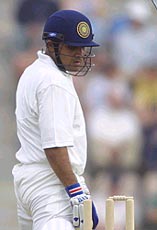Instinct vs Pragmatism
Daniel Laidlaw
Two conflicting cases were made, one for instinct and the other for tactical
pragmatism, late on the second day of the first Test. On the one hand,
converted opener Virender Sehwag batted freely in a cavalier innings of 84
off 96 balls before his attacking tendency brought about his dismissal with
only three overs of play remaining. And on the other, a conservative attempt
to protect Sachin Tendulkar from the fray until the next day backfired when
nightwatchman Ashish Nehra was trapped lbw in the last over. Talk about
damned if you do and damned if you don't.
Firstly Sehwag, a highly promising Test batsman to put it mildly. From the
start of his first innings as Test opener, effectively with Rahul Dravid, he
played what appeared to be his natural game. Livelier wickets may be more
informative, but the reputed technical deficiency outside off appears to be
a myth. For Sehwag batting success seems mainly a matter of judgement,
balancing his uninhibited strokes with due caution. For 84 runs, Sehwag was
an attacking treat, until he walked marginally on the wrong side of that
fine line.
 Now, one could criticise Sehwag for impetuosity, of attempting too much
against Giles, not putting his head down and playing for stumps, adapting to
the situation, etc. However, one can't really have it both ways. Looking to
hit a delivery on leg to mid wicket, Sehwag got an inside edge onto pad and
it trickled onto the stumps. Bad luck. It happens. His unrestrained approach
had just brought him 84 runs in the session, and if had happened five overs
earlier, or five overs before that, the same case could have been made
against him for throwing his wicket away when a Lord's debut century
beckoned.
Now, one could criticise Sehwag for impetuosity, of attempting too much
against Giles, not putting his head down and playing for stumps, adapting to
the situation, etc. However, one can't really have it both ways. Looking to
hit a delivery on leg to mid wicket, Sehwag got an inside edge onto pad and
it trickled onto the stumps. Bad luck. It happens. His unrestrained approach
had just brought him 84 runs in the session, and if had happened five overs
earlier, or five overs before that, the same case could have been made
against him for throwing his wicket away when a Lord's debut century
beckoned.
Just because stumps were looming should not make too much difference to the
critique. Runs are runs, India needed them any time, and the fatal shot was
not a special extravagance in the context of his innings. Sehwag reportedly
won the opener's berth because of that positive approach. It would have been
a different matter entirely had Dravid been dismissed attempting the same
shot, as it would have been against the character of his innings. For
Sehwag, it really wasn't.
Sehwag's knock was quite similar to the type often played by Michael Slater
for Australia. Slater has been frustratingly dismissed around nine times in
the 90s attempting the impetuous, sometimes towards the end of play.
However, his overall record, and the number of matches he has influenced
batting in that fashion, has vindicated the approach. As with Slater, Sehwag
's unrestrained method will sometimes be costly, but the upside is too great
to hold him back, as was demonstrated by the start he gave India. Depending
on the objective, one could even argue that Sehwag's contribution, including
his dismissal, was more valuable than that of Dravid.
On the side of conservative tactics is the eternally confusing concept of
the nightwatchman. Following Sehwag's dismissal, Ashish Nehra was sent out
to prevent Sachin Tendulkar from facing the last three overs. That, by
itself, was questionable. Whether it is worth potentially expending a lower
order wicket to prevent an accomplished top order one from having to start
and re-start an innings, possibly affecting run-making the next day, is
dubious. It's certainly negative. What is definitely counter-productive,
though, is when that nightwatchman attempts to protect not only his reticent
team-mate in the dressing room, but also his well-established partner.
In the last over of the day, Nehra edged Flintoff to third man and elected
not to take the single to get Dravid on strike. This defies logic. Nehra was
sent in to protect what would have been a new batsman in Tendulkar, not
Dravid. Dravid had been batting for two and a half hours without discomfort,
making him eminently qualified to see out the remainder of play. And yet
Nehra, just arrived at the crease and having survived two lbw appeals, was
allowed to shield Dravid from the strike for the final few balls.
 Surely, India needed to value all their wickets, irrespective of the time of
day. It is ironic to think that had the same two batsmen just been brought
together at the *end* of the innings, it would have been Dravid shielding
Nehra instead of the other way around. What earthly difference does it make
that it is the last over of a day towards the beginning of an innings rather
than the end? Wickets are wickets, it's bad to lose them any time, and Nehra
was obviously the more vulnerable of the two. Besides, if it was Tendulkar
out there instead of Nehra, the secure Dravid could have played the shepherd
and protected Tendulkar from much the strike anyway, which he would have
been much more capable of doing.
Surely, India needed to value all their wickets, irrespective of the time of
day. It is ironic to think that had the same two batsmen just been brought
together at the *end* of the innings, it would have been Dravid shielding
Nehra instead of the other way around. What earthly difference does it make
that it is the last over of a day towards the beginning of an innings rather
than the end? Wickets are wickets, it's bad to lose them any time, and Nehra
was obviously the more vulnerable of the two. Besides, if it was Tendulkar
out there instead of Nehra, the secure Dravid could have played the shepherd
and protected Tendulkar from much the strike anyway, which he would have
been much more capable of doing.
The Australians were right to ditch this tradition (which, more than a
tactic, is what it seems to be). The nightwatchman concept belongs to the
past, the era of uncovered wickets, without a place in the modern game.
P.S. Simon Jones, Simon Jones, Simon Jones. We seek him here, we seek him
there. We see him nowhere. Well, at least not until 14 ball-softening
shine-dissipating overs had passed, anyway.
The new England fast man all commentators seemed to be talking about in
anticipation lived up to his billing on his first day of Test action, with
his sharp pace delivered from height. Jones' spirited innings of 44 before
he took the ball was unexpected and entertaining, and doubtless did wonders
for his confidence. So why did Nasser Hussain delay his entry into the
bowling attack for so long?
High on confidence after his batting exploits, the pro-active course of
action would have been to throw Jones the new ball with Hoggard and let him
continue his momentum. Apart from allowing debut nerves to possibly build up
after they must have been settled by his batting, the decision to hold Jones
back until second-change after Giles was more importantly a waste of finite
resources, i.e. the new ball. On a flat batting pitch, the optimum time to
strike was with a new ball that may do something, as Zaheer Khan showed with
both first and second. Yet Hussain kept his most explosive weapon in
reserve.
Maybe the strategy was to bluff India by keeping them in anticipation, but
after Hoggard bowled Jaffer in the first over it surely would have made most
sense to attack the top order with raw pace to try to prise out more
precious early wickets. It may not have worked, but on a flat pitch England
would have lost nothing in the attempt.
More Columns
Mail Daniel Laidlaw